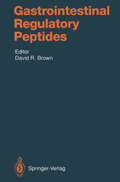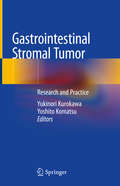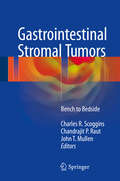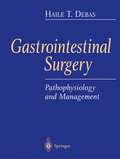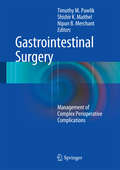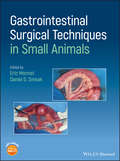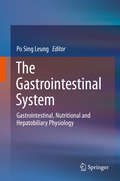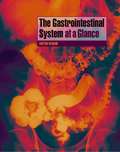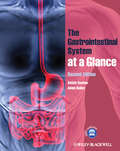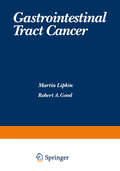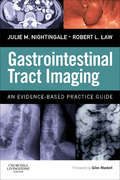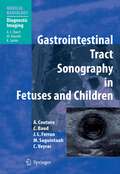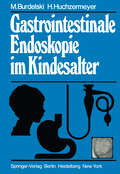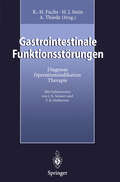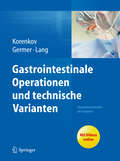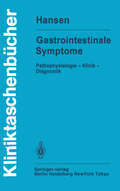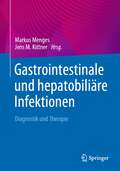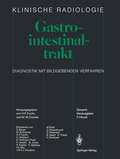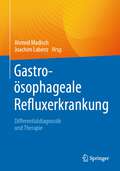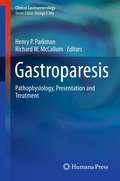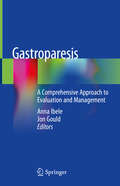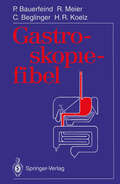- Table View
- List View
Gastrointestinal Regulatory Peptides (Handbook of Experimental Pharmacology #106)
by A. Alemayehu B. Amiranoff D. L. Barber S. R. Bloom J. Calam R. E. Carraway Feng Chen C. S. Chew C. C. Chou J. M. Conlon A. Couvineau E. Ekblad T. S. Gaginella J. J. Galligan J. R. Grider R. Hakanson P. Kitabgi M. Laburthe Y. P. Loh M. S. O'Dorisio S. M. O'Grady R. K. Pearson R. J. Playford E. Rozengurt F. Sundler I. ZacharyThe most comprehensive and conceptual one-volume treatment of this field available and the first to emphasize the cellular and molecular aspects of gut peptide biology. Authored by an array of internationally distinguished scientists, it deals with issues of peptide localization and biosynthesis in gastrointestinal cells, mechanisms of peptide release and inactivation and the nature of peptide receptors. The breadth and readability make it an invaluable reference source for scientists in all disciplines interested in any aspect of brain-gut peptides.
Gastrointestinal Stromal Tumor: Research and Practice
by Yukinori Kurokawa Yoshito KomatsuThis book provides a comprehensive and up-to-date overview of gastrointestinal stromal tumors (GISTs). GISTs represent the most common mesenchymal neoplasms arising within the gastrointestinal tract. The causative gene of this disease was originally discovered in Japan by Prof. Seichi Hirota in 1998, and since then numerous important advances – from basic to clinical aspects – have been reported from Japan. Professionals involved in the management of GISTs inevitably cite significant evidence and the state-of-the-art treatments from the Asian region, where has there is and inherently high prevalence of gastrointestinal cancers. Each expert author elucidates the cutting-edge knowledge on pathophysiology, diagnosis, and treatment of GISTs, especially focusing on the highly valuable data from Japan. This attractive collection benefits not only oncologists but also basic researchers, general physicians and surgeons, as well as paramedical staff and medical students who are dealing with GISTs.
Gastrointestinal Stromal Tumors: Bench to Bedside
by Charles R. Scoggins Chandrajit P. Raut John T. MullenThis textbook provides a comprehensive, state of the art review of this field, and will serve as a valuable resource for clinicians, surgeons and researchers with an interest in GIST. The book reviews new data about risk factors for the disease, profiles the new staging system for GIST, highlights our current understanding of genetic mutations that lead to GIST, and provides new perspectives about imaging of GIST tumors. For localized disease, a greater appreciation of organ-sparing approaches and the importance of preservation of gastrointestinal function is discussed in detail, and advances in surgical techniques are highlighted, including minimally invasive surgery. For metastatic disease, the molecular biology of GIST is reviewed in a detailed and understandable manner, including the data that has fostered novel targeted approaches that have revolutionized management. Several landmark trials have been published in the last few years and are placed in context with respect to current management. Integration of surgery and systemic therapy through consolidative approaches has yielded provocative data that promises to further advance the field, and major advances in this domain are also discussed. Gastrointestinal Stromal Tumors: Bench to Bedside will serve as a very useful resource for physicians and researchers dealing with, and interested in, this challenging malignancy. It provides a concise yet comprehensive summary of the current status of the field that will help guide patient management and stimulate investigative efforts. All chapters are written by experts in their fields and include the most up to date scientific and clinical information.
Gastrointestinal Surgery: Pathophysiology and Management
by Haile T. DebasGastrointestinal Surgery: Pathophysiology and Management is an invaluable reference text for surgeons and surgical trainees. Written entirely by Dr. Haile T. Debas, Dean of School of Medicine and former Professor and Chairman, Department of Surgery, at the University of California, San Francisco, this book provides the unified approach only found in a single-authored text. Based on the three pillars of understanding particular disease processes -- fundamental anatomy and physiology, pathopysiology, and clinical correlations -- surgical treatment of GI disease is presented as the means to correct abnormal physiology and restore health. Using an integrated approach of basic science and clinical practice, Dr. Debas allows the student of surgery to gain a solid understanding of disease processes that minimizes the need for rote memorization. Thirteen lavishly illustrated chapters cover the GI system as well as gastrointestinal peptides and peptide-secreting tumors, abdominal trauma, the abdominal wall, surgery for morbid obesity, the liver, spleen, retroperitoneum, and perioperative care. Dozens of summary tables throughout each chapter condense "essentials" for quick reference. Comprehensive discussions of clinical disorders review the surgical treatment options. With 400 illustrations and tables, including hundreds of anatomical line drawings commissioned exclusively for this textbook, Gastrointestinal Surgery provides a clinical and therapeutic approach to surgical diseases which will prove invaluable to the surgical trainee and the practitioner preparing for recertification.
Gastrointestinal Surgery: Management of Complex Perioperative Complications
by Timothy M. Pawlik Shishir K. Maithel Nipun B. MerchantAdvances in surgical technique and broadening indications for complex gastrointestinal procedures, surgical management of thoracic, hepato-pancreato-biliary, and colorectal diseases continues to evolve, but morbidity continues to be a persistent problem. This book provides a comprehensive, state-of-the art, definitive reference for the diagnosis and management of difficult-to-manage complications following advanced gastrointestinal surgery. All chapters are written by experts in their field and include the most up-to-date clinical information from national and world leaders in their respective discipline. The text provides a practical, clinically useful guide that reviews risk factors for these complications and offers key information on how to avoid potentially high morbidity events in the peri-operative period. It also discusses the management of these problems when they do occur. With its helpful guidelines and “tricks of the trade” to avoid potential complications, this book is essential to all medical professions treating such patients.Gastrointestinal Surgery: Management of Complex Perioperative Complications is of great value and utility for general surgeons, thoracic surgeons, upper gastrointestinal surgeons, colorectal surgeons, hepato-pancreato-biliary surgeons, surgical oncology fellows, thoracic surgery fellows and upper level residents in general surgery.
Gastrointestinal Surgical Techniques in Small Animals
by Eric Monnet Dan SmeakGastrointestinal Surgical Techniques in Small Animals offers a highly detailed reference to surgical procedures in the gastrointestinal tract in dogs and cats. Each chapter describes the surgical techniques in depth, featuring high-quality illustrations depicting each step, and discusses tips and tricks for a successful surgery and potential complications. A companion website offers video clips demonstrating the procedures. Logically divided into sections by anatomy, each chapter covers indications, contraindications, and decision making for a specific surgery. Tips and tricks and potential complications are also covered. Describes techniques for canine and feline gastrointestinal surgery in detail Presents the state of the art for GI surgery in dogs and cats Includes access to a companion website with video clips demonstrating techniques Gastrointestinal Surgical Techniques in Small Animals is an essential resource for small animal surgeons and veterinary residents.
Gastrointestinal Surgical Techniques in Small Animals
by Eric Monnet Daniel D. SmeakGastrointestinal Surgical Techniques in Small Animals offers a highly detailed reference to surgical procedures in the gastrointestinal tract in dogs and cats. Each chapter describes the surgical techniques in depth, featuring high-quality illustrations depicting each step, and discusses tips and tricks for a successful surgery and potential complications. A companion website offers video clips demonstrating the procedures. Logically divided into sections by anatomy, each chapter covers indications, contraindications, and decision making for a specific surgery. Tips and tricks and potential complications are also covered. Describes techniques for canine and feline gastrointestinal surgery in detail Presents the state of the art for GI surgery in dogs and cats Includes access to a companion website with video clips demonstrating techniques Gastrointestinal Surgical Techniques in Small Animals is an essential resource for small animal surgeons and veterinary residents.
The Gastrointestinal System: Gastrointestinal, Nutritional and Hepatobiliary Physiology
by Po Sing LeungGastrointestinal (GI) physiology is a fundamental subject that is indispensable not only for undergraduate but also for graduate courses. The audience include, but are not limited to, medical, pharmacy, nursing, human biology, Chinese medicine, and science students, as well as other health-related subject students. The overall objectives of this textbook are to present basic concepts and principles of GI physiology and, more importantly, to convey an understanding of how to apply this knowledge to abnormal GI physiology in the clinical context. As such, the basic knowledge of GI physiology and its application in the form of clinical case studies should be grasped, which are critical for professional examinations and bedside, as well as for general practice in the future. In this handbook, we aim to achieve these elements by covering the breadth of GI, pancreatic, hepatobiliary, and nutritional physiology. Moreover, we include relevant scenario-based clinical case in each chapter so as to evaluate whether the students can apply the basic GI they learn to the clinical setting.
The Gastrointestinal System at a Glance
by Satish KeshavThe latest system based addition to the At a Glance series, The Gastrointestinal System at a Glance is a concise and integrated text on the gastrointestinal system. The book is intended as an authoritative and concise account of the field covering anatomy, physiology, biochemistry, pharmacology, and pathology as well as clinical management. The book is divided in to four sections: Basic Structure and Function, Integrated Function and Disorders and Diseases as well as a short section on Diagnosis and Treatment. The structure of the book takes the student from the basic sciences to clinical practice whilst always maintaining an integrated balance and understanding of both aspects. Fantastic diagrams that include a quick summary of clinical presentations will aid students to learn and revise. The Gastrointestinal System at a Glance is ideal as an introduction to the subject, as a companion book for a course, and as a book for revision prior to examinations.
The Gastrointestinal System at a Glance (At a Glance)
by Satish Keshav Adam BaileyThis concise introduction to the gastrointestinal system encapsulates the fundamental facts and principles of this rapidly growing and changing specialty. Written by experienced clinicians and teachers, the text covers the basic concepts of both the science surrounding the gastrointestinal system and the basics of clinical practice in an accessible, lucid format.Now fully supported by a companion website at www.ataglanceseries.com/gastro containing interactive MCQs and downloadable digital flashcards, The Gastrointestinal System at a Glance is the ideal revision aid for medical and allied health students, and provides valuable insight for anyone seeking a comprehensive and concise guide to this subject area. Fully revised and updated to include further coverage of diagnostic and therapeutic endoscopy, revised liver chapters and a new chapter on embryology Now in full colour throughout Supported by a companion website containing interactive self-assessment and digital flashcards - perfect for both study and revision Provides an integrated approach to both the basic and clinical science of this core specialty
The Gastrointestinal System at a Glance (At a Glance)
by Satish Keshav Adam BaileyThis concise introduction to the gastrointestinal system encapsulates the fundamental facts and principles of this rapidly growing and changing specialty. Written by experienced clinicians and teachers, the text covers the basic concepts of both the science surrounding the gastrointestinal system and the basics of clinical practice in an accessible, lucid format. Now fully supported by a companion website at www.ataglanceseries.com/gastro containing interactive MCQs and downloadable digital flashcards, The Gastrointestinal System at a Glance is the ideal revision aid for medical and allied health students, and provides valuable insight for anyone seeking a comprehensive and concise guide to this subject area. * Fully revised and updated to include further coverage of diagnostic and therapeutic endoscopy, revised liver chapters and a new chapter on embryology * Now in full colour throughout * Supported by a companion website containing interactive self-assessment and digital flashcards - perfect for both study and revision * Provides an integrated approach to both the basic and clinical science of this core specialty.
Gastrointestinal Tract Cancer (Sloan-Kettering Institute cancer series)
by Martin LipkinIn observing the development of modern scientific knowledge, many indivi duals have expressed concern over the rapid growth of information in various specialized disciplines. Over 100 years ago the first Secretary of the Smith sonian Institution, and more recently Dr. Vannevar Bush while proposing the modern expansion of the National Institutes of Health, both noted prob lems that prevented the proper utilization of information by individuals in medical and related scientific fields. These observations, tagether with con comitant implications of future difficulty, are particularly pertinent to the field of oncology. The rapid evolution of the latter discipline has largely been aided by the incorporation of concepts and methods developed over a long period of time, and drawn from a wide variety of other scientific fields. The large body of discoveries that have contributed to our current understanding of neoplasia, however, cannot be viewed as being made up of equal parts. They bring to mind Claude Bernard's view "des determinismes simples et complexes" in the physiological and biochemical regulation of bod ily functions. He was able to observe that the most important and basic of physiologic processes were destined to be fewer in number than those of less fundamental and more highly specialized purpose. He understood that in the future development of medical science, sturlies of the lauer would occupy much of the time and attention of investigators, and were likely to contribute much to scientific literature.
Gastrointestinal Tract Imaging E-Book: An Evidence-Based Practice Guide
by Dcr R Mrcr Hon Julie M. Nightingale MSc Dcr R Robert L. Law, Dcr R M LawThis book offers a unique insight into the rapidly changing radiology service, and offers introductory chapters which provide the fundamental underpinning knowledge required for safe and effective GI practice. Subsequent chapters discuss the evidence base related to a range of imaging procedures suitable for investigation of upper and lower GI symptoms, supported by key pathology chapters. The book also explores the range of treatments available for the more common GI tract pathology.Multi professional authorship.Detailed evidence-informed explanations of a range of individual GI procedures, including suggestions for problem solving and adaptation of technique.With extensive illustrations, medical images, boxes and tables.References and further reading./ul>
Gastrointestinal Tract Sonography in Fetuses and Children (Medical Radiology)
by Alain Couture C. Baud F.L. Ferran Magali Saguintaah Corinne VeyracThis is a state-of-the-art review of sonography of the gastrointestinal tract in fetuses, neonates and children. An introductory chapter compares sonography and magnetic resonance imaging of the fetal gastrointestinal tract. Coverage focuses on technique, pitfalls and findings in applications including antropyloric diseases, bowel obstruction, bowel wall thickening, colitis, appendicitis, intussusception, abdominal wall and umbilical abnormalities, intraperitoneal tumors and trauma, with high-quality illustrations. Includes a quiz based on 15 case reports.
Gastrointestinale Funktionsstörungen: Diagnose, Operationsindikation, Therapie
by J. R. Siewert K. H Fuchs T. R. DeMeester H. J. Stein A. ThiedeDie Fortschritte in der Behandlung der gastrointestinalen Funktionsstörungen verlangen umfassende Kenntnisse aller diagnostischen Verfahren."Gastrointestinale Funktionsstörungen" faßt das praxisrelevante Wissen für Sie zusammen, veranschaulicht durch zahlreiche Abbildungen und Tabellen.- Alle Verfahren und Entwicklungen der gastrointestinalen Diagnostik und Therapie auf dem neuesten Stand- Pathophysiologie, diagnostische Standards, Differentialtherapie- Indikationen für die operative Therapie- Operationskonzepte und minimal-invasive Techniken- Anleitung und praktische Hinweise für das diagnostische Vorgehen und die therapeutischen KonsequenzenMit diesem neuen Nachschlagewerk sichern Sie sich den aktuellen Kenntnisstand, auf den Sie in der modernen Diagnostik und Therapie nicht verzichten können.
Gastrointestinale Operationen und technische Varianten: Operationstechniken der Experten
by Michael Korenkov, Christoph-Thomas Germer and Hauke LangChirurgische Eingriffe an gastrointestinalen Organen unterliegen trotz Standardisierung und weitreichender Technisierung nach wie vor zum Teil erheblichen Unterschieden. Für alle Chirurgen ist es von großem Interesse, die individuellen technischen Varianten einzelner auf diesem Gebiet ausgewiesener Chirurgen kennen zu lernen und so ihr eigenes operatives Repertoire zu erweitern. In diesem Buch werden die chirurgischen Eingriffe für eine Auswahl wichtiger Operationen von Experten in ihrer spezifischen Vorgehensweise Schritt für Schritt und reich bebildert dargestellt. Zahlreiche renommierte Chirurgen aus dem deutschsprachigen Raum ebenso wie internationale Autoren beschreiben ihr Procedere. Außergewöhnliche und schwierige Situationen, wie unerwartete Befunde, anatomische Varianten oder Blutungszwischenfälle, finden besondere Berücksichtigung.
Gastrointestinale Symptome: Pathophysiologie — Klinik — Diagnostik (Kliniktaschenbücher)
by W. E. HansenAuf Anregung von studentischer Seite wurde der Schwerpunkt die ses Buches auf die Symptomatik gelegt und damit dem Bedürfnis nach "mehr Praxisbezug" Rechnung getragen. Bei der Konzeption habe ich mich von der traditionellen Meinung leiten lassen, nach welcher Anamnese und körperlicher Befund für die diagnostische Strategie das entscheidende Gewicht besitzen und die technischen Untersuchungen der Bestätigung dienen. Am An fang der Kapitel steht ein kurzer Abriß der Pathophysiologie, der zum Verständnis des jeweiligen Symptoms beitragen soll. Es folgt ein Abschnitt über die Klinik, in dem auf Gesichtspunkte der Anam neseerhebung und der körperlichen Untersuchung eingegangen wird; kurzgefaßte Beispiele wichtiger Krankheitsbilder schließen sich an. Danach wird die Diagnostik bei den jeweiligen Symptomen abgehandelt, z. T. in schematisierter Form. Zur Ergänzung des Textes finden sich ausgewählte Literaturangaben an den Kapitelenden. Ziel der Darstellung ist, in geraffter, anwendungsbezogener Form die wesentlichen Kenntnisse über gastrointestinale Beschwerden und diagnostische Schlußfolgerungen zu vermitteln. Vieles wird da her in Übersichten und Tabellen zusammengefaßt. Andererseits lie ßen sich, um Zusammengehöriges klar und möglichst vollständig zu erfassen, Wiederholungen nicht vermeiden. Besonderes Gewicht er hielten sinnlich wahrnehmbare Merkmale: deshalb erfolgte auch die Aufnahme des Kapitels über dermatologische Veränderungen (Kap. 10) mit ausführlichem Bildteil, welche bisher in der deutsch sprachigen gastroenterologischen Literatur weitgehend ausgespart blieben. Typische technische Befunde, z. B. im Rahmen der Rönt genuntersuchungen oder der Endoskopie, werden bewußt nicht ge zeigt, sie können der Vielzahl der einschlägigen Lehrbücher entnom men werden.
Gastrointestinale und hepatobiliäre Infektionen: Diagnostik und Therapie
by Markus Menges Jens M. KittnerWeltweit gehören gastrointestinale Infektionen zu den häufigsten erregerbedingten Erkrankungen überhaupt und zählen zu den 10 häufigsten Todesursachen insbesondere bei Kindern. Im Rahmen des Infektionsschutzgesetzes meldepflichtigen Erkrankungen in Deutschland spielen gastrointestinaler Infektionen mit bis zu 60% die wichtigste Rolle (z.B. Noro- und Rotaviren).Die gastroenterologische Infektiologie erfährt derzeit einen rasanten Bedeutungszuwachs durch die weitreichenden Resistenzprobleme infolge des häufig ungezielten Einsatzes von Antibiotika (insbesondere MRGN), der zunehmenden Herausforderung einer alternden Bevölkerung mit steigender Komorbidität und Infektionsanfälligkeit sowie durch die besonderen Herausforderungen von migrationsassoziierten Infektionskrankheiten.Kompakt und konzentriert stellt das Praxisbuch die wichtigsten infektiösen Erkrankungen und das diagnostische und therapeutische Vorgehen dar. Das Praxisbuch startet mit den Grundlagen zur Epidemiologie, Labordiagnostik, Hygiene und Meldepflichten. Das Kernstück sind die unterschiedlichen bakteriellen und viralen Gastroenteritiden. Aber auch gastrointestinale Infektionen nach einem Tropenaufenthalt oder in Zusammenhang mit sexuell übertragbaren Erkrankungen, welche in der Differentialdiagnostik mit bedacht werden sollten, finden Erwähnung. Der bedeutende Erreger Helicopacter pylori mit seinen diagnostischen und therapeutischen Ansätzen wird ebenfalls ausführlich beschrieben. Eine passende Ergänzung erhält der Leser durch das Management hepatobiliärer Infektionen.Ein gelungenes Praxisbuch für alle Internisten Gastroenterologen und Infektiologen - insbesondere für Weiterbildungsassistenten und junge Fachärzte. Aber auch Hausärzte finden hier hilfreiches Wissen für eine sichere Diagnostik und erfolgversprechende Therapie. Denn rasches und richtiges Handeln kann Schaden nicht nur vom Betroffenen, sondern potenziell auch von der Umgebung abwenden.Sicherheit im Handeln bei gastroenterologischen und hepatobiliären Infektionen.
Gastrointestinaltrakt: Diagnostik mit bildgebenden Verfahren (Klinische Radiologie)
by D. Beyer M. W. Donner H. F. Fuchs A. Hellstern K. Hofmann-Preiß K. Jessen B. Jones R. Köster K. Mathias C. Nitz J.W.A.J Reeders W. Rödl G. Rosenbusch D. Rübesam B. Swart E. Trüber H. WorlicekIn diesem Band werden alle Teile des Gastrointestinaltraktes durch international anerkannte Spezialisten behandelt und alle modernen bildgebenden Verfahren erfaßt. Neben dem Schwerpunkt der konventionellen Röntgendiagnostik werden die neuen bildgebenden Verfahren wie Ultraschall, Computer- und Kernspintomographie einbezogen. Besonderer Wert wurde auf das Doppelkontrastverfahren des gesamten Gastrointestinaltraktes gelegt. Auch die Belange der modernen Endoskopie, sowie Besonderheiten im Kindesalter werden gewertet. Das hervorragende Bildmaterial erleichtert die Nutzung der Informationen für die tägliche Arbeit der Internisten und Radiologen der Fachgebiete.
Gastrointestinaltrakt: Mukosale Pathophysiologie und Immunologie
by Erika Jensen-JarolimUmfassend: Dieser Ein- und Überblick über pathophysiologische Prinzipien als Basis zu Klinik, Diagnostik und Therapie des Gastrointestinaltraktes. Ausführlich geht die Autorin auf die Beteiligung des mukosalen Immunsystems ein. Verständlich schildert sie basale Prinzipien der Allergo- und Immunologie. Anschauliche, selbsterklärende Illustrationen sind durch weiterführende Texte ergänzt. Ideale Lernhilfe für alle Studierenden der (Zahn)medizin.
Gastroösophageale Refluxerkrankung: Differentialdiagnostik und Therapie
by Ahmed Madisch Joachim LabenzIn diesem Praxisbuch haben Experten auf diesem Gebiet das aktuelle Wissen zur Differenzialdiagnostik und zur Therapie - konservativ bis operativ - zusammengefasst.Das klinische Bild der Refluxkrankheit ist sehr vielfältig. Neben den klassischen Symptomen Sodbrennen und Schmerz hinter dem Brustbein können auch atypische Beschwerden wie Asthma, chronischerer Husten und Heiserkeit als Folge der Refluxerkrankung auftreten. Im schlimmsten Fall kann sich auch als Folge eines langjährigen Refluxes Speiseröhrenkrebs bilden. Insbesondere bei atypischen Symptomen ist aber die Diagnostik erschwert. Hier muss die klinische Expertise durch differenzierten Einsatz von apparativer Diagnostik ergänzt werden. Dieses Praxisbuch leistet eine Hilfestellung in der Funktionsdiagnostik und erläutert mögliche Diagnoseverfahren. Im Therapieteil werden konservative wie auch operative Optionen mit notwendigen Indikationen aufgezeigt. Kapitel zu den Besonderheiten bei Kindern mit Reflux und einem Auftreten bestimmter Symptome während der Schwangerschaft runden das Buch ab. Die Inhalte orientieren sich an der aktualisierten Leitlinie „Gastroösophageale Refluxkrankheit“.Neben der hohen Prävalenz und der deutlichen Einschränkung der Lebensqualität liegt die Bedeutung der Erkrankung im breiten klinischen Spektrum an Symptomen, Komplikationen und Folgeerkrankungen mit Relevanz für zahlreiche Fachdisziplinen auch außerhalb der Gastroenterologie. So bietet dieses Buch einen kompakten Wissenstranfer zum Krankheitsbild - nicht nur für Gastroenterologen.
Gastroparesis: Pathophysiology, Presentation and Treatment (Clinical Gastroenterology)
by Henry P. Parkman and Richard W. McCallumGastroparesis is an increasingly recognized disorder. Treatment can be difficult due to the several mechanisms for symptom production. Gastroparesis: Pathophysiology, Presentation and Treatment serves as a concise reference on this disorder that allows clinicians to quickly access and evaluate the necessary information for treating and managing patients with gastroparesis. Each chapter is written by experts in their respective area. The volume will enable the reader to better understand all aspects of this disorder. The book presents current concepts in a variety of areas opening with the epidemiology, clinical presentation and pathophysiology of gastroparesis. The natural history of patients is explored as well as evaluation of patients with suspected gastroparesis. This section includes chapters on Wireless Capsule Motility, Electrogastrography and Antroduodenal Manometry. This important resource concludes with a full section on treatment including dietary, prokinetic, antiemetic, sensory, electric stimulation, and surgical methods. New developments include the use of gastric electric stimulation for treatment, the use of SmartPill for diagnosis, and a number of new agents in development for this disorder. Gastroparesis: Pathophysiology, Presentation and Treatment is the ideal reference for gastroenterologists, and also for surgeons, endocrinologists, primary care physicians and nutritionists looking to keep pace with the latest information treatment options for their patients.
Gastroparesis: A Comprehensive Approach to Evaluation and Management
by Anna Ibele Jon GouldThis book presents a comprehensive approach to the diagnostic evaluation of gastroparesis and the medical and surgical treatment options available for this disorder. The initial chapters address the different etiologies, pathophysiology and diagnostic evaluation of this disease. Medical management, nutritional support and co-morbid conditions are also discussed. Subsequent chapters focus on endoscopic and surgical options for management and the current outcomes data for these procedures. A brief review of the existing literature addressing the particular topic is included in each section.Written by experts in the field, Gastroparesis covers each of these treatment sections that address patient selection, technical conduct and complications of the most common endoscopic procedures and operations, and anticipated outcomes of therapy.
